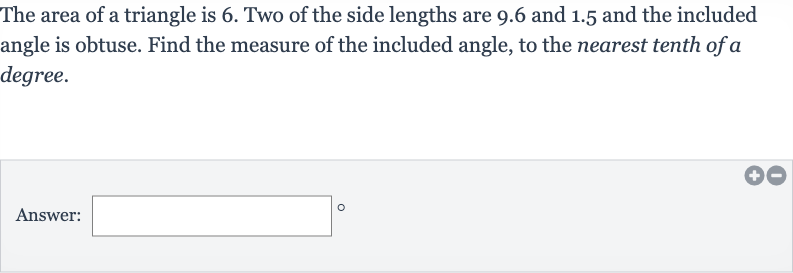AI tutor
Welcome to Bytelearn!
Let’s check out your problem:

The area of a triangle is . Two of the side lengths are . and . and the included angle is obtuse. Find the measure of the included angle, to the nearest tenth of a degree.Answer:
Full solution
Q. The area of a triangle is . Two of the side lengths are . and . and the included angle is obtuse. Find the measure of the included angle, to the nearest tenth of a degree.Answer:
- Set up equation: To find the measure of the included angle, we can use the formula for the area of a triangle when two sides and the included angle are known: , where and are the sides and is the included angle.Given that the area is , and the sides are and , we can set up the equation:
- Solve for sin(C): Now we need to solve for sin(C). First, we multiply and , then divide both sides of the equation by the result to isolate sin(C):
- Calculate sin(C): Perform the calculations to find the value of sin(C):
- Find angle C: Since the angle is obtuse, it is between degrees and degrees. The sine function is positive in both the first and second quadrants, but we are looking for an angle in the second quadrant (since it's obtuse).To find the angle , we take the inverse sine (arcsin) of the value we found for . However, since arcsin will give us an angle less than degrees, we need to subtract that angle from degrees to find the obtuse angle.Let's first find the acute angle:
- Find acute angle: Using a calculator to find the gives us an acute angle. However, we need to ensure that the calculator is set to degree mode, not radian mode, to get the correct angle measurement. degrees
- Find obtuse angle: Now we subtract the acute angle from degrees to find the obtuse angle: degrees
More problems from Inverses of trigonometric functions using a calculator
QuestionGet tutor help
QuestionGet tutor help
QuestionGet tutor help
QuestionGet tutor help
QuestionGet tutor help
QuestionGet tutor help
Question
. Find the value of in degrees.Write your answer in simplified, rationalized form. Do not round.____
Get tutor helpQuestionGet tutor help
